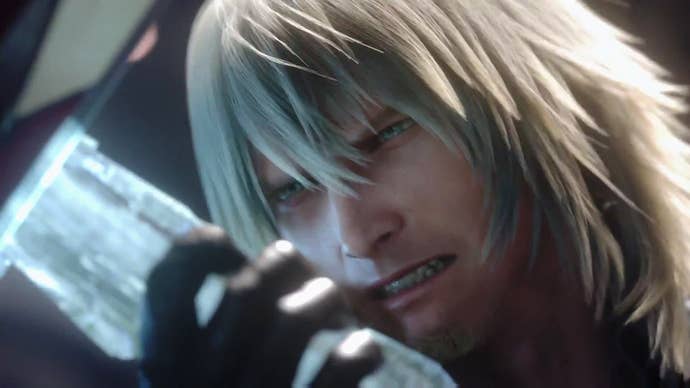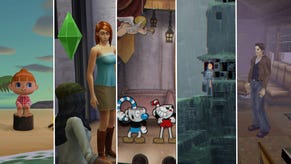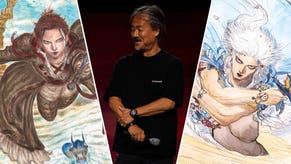Lightning Returns: Final Fantasy XIII Full E3 Interview
Our in-depth conversation with director Motomu Toriyama and producer Yoshinori Kitase digs into the details and mechanics of the grand finale of the tumultuous Final Fantasy XIII saga.
This article first appeared on USgamer, a partner publication of VG247. Some content, such as this article, has been migrated to VG247 for posterity after USgamer's closure - but it has not been edited or further vetted by the VG247 team.
Last week, I had the chance to go hands-on with Lightning Returns: Final Fantasy XIII and get a feel for its combat system (it's great, basically). I also spoke with the game's producer Yoshinori Kitase and director Motomu Toriyama to dive deep on some of Lightning Returns' deeper mechanics and long-term design philosophy.
USgamer: How far along is Lightning Returns?
Yoshinori Kitase: In terms of how far along we are, we’re at the final stages of our development. We’ve incorporated all of the game mechanics that are supposed to be in the game. We have our test players and our dev staff… It’s set up so they can play it all the way through to the end. They’re going through the process of checking for bugs and glitches and brushing it up from there.
Motomu Toriyama: We’re going to be performing some more user testing to make sure everything is in order.
USG: I was surprised when the game was delayed until next year, since I’d originally heard it was going to be released this year. Why did you decide to push it back?
YK: In Japan, for reference, we’re planning to release that version of the game in November. I’m afraid that, yes, the overseas version is going to be delayed past that time. We’ve said earlier that the development status is in its final stages. We’ve built in whatever game mechanics are going to be in there. But since “world-driven” is one of our concepts, and our environment is a very important element of the game, we wanted to depict it as realistically as possible. We also want to allow for a very free and open experience exploring the world.
With the depiction of the world and the environment, another important element is the NPCs. We want to be able to depict them in a very realistic way as well, which leads to the dialogue. We want to take our time and be very thorough with our localization process and make sure that we have something that is relatable, that transfers well to our overseas audience. It is a little bit later than the Japanese release, unfortunately, but we’re doing this to make sure that we have the best quality possible.

USG: When you say “world -driven”... Final Fantasy games have always been about their worlds to some degree. What about Lightning Returns makes it different or remarkable compared to previous Final Fantasy games?
YK: As far as what’s different from other Final Fantasy games, this is the first Final Fantasy that is offline -- not like Final Fantasy XI or XIV that are online -- but the first offline Final Fantasy game that actually depicts the movement and transition of time. You’ll see scenes transition from morning to noon to night.
?USG: Let's talk about Lightning’s relationship with the world. In a lot of RPGs, Final Fantasy included, there’s a sense of a journey, of going from one place to another and always leaving behind the places you go. But there have been some Final Fantasy games that have broken away from that. Final Fantasy VIII had the Garden; Final Fantasy XII revolved around Rabanastre. Are you going for that sense of a place to inhabit, or are you still pushing more towards lots of exploration, moving beyond where you are and finding new places to explore?
YK: The world is set up with four different continents and areas. With the whole world, like I mentioned earlier, there’s a 24-hour movement of time. People are living on each part of the world and going through their daily lives. With this system, you can travel freely after you finish the tutorial section in the very beginning. You’ll be exploring, but the player can also choose, because there’s that movement of time… For example, there’s a special instance that only happens at night on Luxerion. The player can decide if they want to wait around on Luxerion and see what happens when night falls, or they can choose to move around and travel to different continents instead. We’ve mixed that up.
USG: So the world is fairly open to explore from the very beginning?
MT: Yeah, the world is very freely set up, so that you can travel wherever you want to. But it’s kind of tiered. You can explore all you want within the one continent and travel freely there, but you can also travel to each different continent as well.
USG: Has it been difficult to adjust the difficulty of the combat system for that more open approach? Becoming stronger is an integral part of how Final Fantasy works, with your characters getting new skills and better weapons and that sort of thing. How have you approached balancing the difficulty of the action and the combat, so that it’s not too hard in some places or too easy to become stronger?
YK: It is very free to explore, but at the same time, we also have to keep in mind that there’s a limited amount of time. The world is ending, and Lightning has a very short amount of time left to be able to move around freely. We’ve worked the game balance, the difficulty balance to relate to the progress of time. For example, if you only have five days left until the end of the world, the difficulty of a monster may change. We’ve incorporated that as well. Also, we have the traditional way of leveling up, where she’ll have to travel from place to place and strengthen her skills and upgrade her abilities.

USG: What happens if you don’t finish the game’s plot, if you don’t win before time runs out? Previously, you've said that was something you were still trying to work out. I assume that with the game having pretty much completed development at this point, you have a good sense of how that’s going to happen. Can you talk more about that deadline and what happens to players as they try to manage time?
YK: There is an update. The player is going to be given seven days at the beginning. The total amount of time left is 13 days, but Lightning only has seven days available to work with. There are going to be different quests that she’ll have to complete. The main quest is to release the spirits of the people in this current world, which will prolong the life of the world up to the 13 days. The first deadline is actually just to extend the life of the world up to that 13 days. That’s the first challenge. If you’re not able to finish the game by that deadline, it means game over, so you’d have to start over.
USG: Is there a New Game+ mode for people to make it easier the second time through?
YK: There will be a sort of New Game+, where you’ll start the new game, but continue to carry the abilities and weapons you picked up in your last playthrough. The more times you replay, the more efficient you’ll be at going through the quests and fighting battles.
USG: You said that, as time advances, the monsters can change and become more difficult. I assume the world changes over time as well. Given that you’re free to travel wherever you like, has it been difficult making the game world evolve through the course of the story, given its size and all the freedom players have?
MT: What was challenging is that, because I’ve been working with the traditional Final Fantasy games – where a player moves through the story, completes one task, and then goes forward in this very linear structure – it’s difficult to switch your thinking to imagine the game being set up in a way where the player doesn’t have to worry about just this one thing in the progression. We’re incorporating the ability to do multiple different things simultaneously, and we’ll be brushing that up in the final tweaking process.
USG: Does this mark the end of the Final Fantasy XIII games? Seven years ago, Final Fantasy XIII was announced with all its related games, Agito and Versus. Agito became Type-0, and of course Versus now is Final Fantasy XV. Final Fantasy XIII sort of stands alone now, but it's still a trilogy. I’m curious to hear your take on that.
MT: In terms of the Lightning saga, the Final Fantasy XIII story, it’s going to end with Lightning Returns: Final Fantasy XIII. We’re definitely aiming for this to be a conclusion, a final end to that chunk of the story. In XIII-2, we were looking at expanding the world view and the story through downloadable content novellas and things like that, but with Lightning Returns, we want to bring closure to these stories, so that our fans can look at this latest installment and have a conclusion to Lightning’s story.
USG: So you won’t be offering DLC for Lightning Returns?
MT: No, we’re not planning on any kind of episodic DLC that would move the story any further than the conclusion. We plan to have it end in the packaged version. We also want to bring closure to the other characters that have made an appearance in past installments.
USG: As far as how the game plays, Lightning Returns has very action-driven combat focused on a single character. Based on what I saw last night, Final Fantasy XV seems to have a very action-driven combat system as well. Final Fantasy XIV, of course, is online, so it’s very real-time, action-oriented. Is this the future you see for the Final Fantasy series, or do you think there’s still room for the classic menu-driven, turn-based style that those of us who grew up playing Final Fantasy still think of sometimes as Final Fantasy?
YK: As far as the action basis… These are very action-driven, the battles in Lightning Returns, as well as what you saw in the demo for Final Fantasy XIV and the trailer for Final Fantasy XV. But if you look at it closely, there’s a different flavor for each title. What we do with the Final Fantasy battle system is that we’ll take a new installment of the game and think about how to structure the battle mechanics in that game. Not so much as we go along, but we think about it and we start from scratch with each installment that we bring in. It might have some similarities in terms of being action-driven, but even, for example, Kingdom Hearts – that kind of action versus what we have prepared for Lightning Returns is a different flavor.
Even more, with Lightning Returns, we have the evolved ATB system. We have the three different styles that we switch between. That’s very different from any of the other titles that we’ve been doing. So we can’t quite say what direction we see in the future for our battle systems might be. With Lightning Returns, we do have the action-driven element, but we also have elements of strategy, where you have to hit the enemy’s weak point to knock it down, or watch your timing on how your gauges are filling up. We feel like that’s reminiscent of traditional Final Fantasy strategy. We’re hoping that people who grew up with the Final Fantasy series will find that strategy element enjoyable.
MT: Would you want to see a turn-based system?

USG: I like both styles. Sometimes action is interesting and sometimes turn-based is interesting. I can enjoy Dragon Quest as much as I enjoy Final Fantasy or Tales or something like that.
YK: Here’s a hypothetical question. We’re not making any statements about this. But what if, say, we were to take a game like Final Fantasy VI? That has the ATB gauges, but it’s basically menu-driven. What if we were to breathe new life into that and make it into a current-generation game. Would players be okay with it still using that turn-based, command-based battle system?
USG: Yeah, I think so. That game in particular has a lot of fans who love the game the way it is. I think that something that remains true to its origins would still appeal to fans a lot. I think turn-based combat can still be very appealing to people. Fire Emblem has been very popular here in America lately. There’s clearly an audience for that. It resonates with people.
MT: The reason why a lot of turn-based games are the way they are is because the characters are basically simple. They’re just a static symbol, so it makes sense to have that there. But now that we have higher-quality graphics and the HD full animation for the characters, it looks kind of awkward if they just stand there and face each other and wait. [laughs] That’s one of the reasons why we’ve incorporated more of this sense of speed in the battle system.
USG: That’s true. But at the same time, turn-based combat lets you do things you can’t do. In Lightning Returns, you control Lightning. You have that single character. But in Final Fantasy VI you have those four party members. It creates different strategies and a different experience. I think that if you’re using the different approaches for the right reasons, to enrich the combat, people may not necessarily mind so much that you have the downtime or the more symbolic nature to the characters. That’s my impression, anyway.
YK: It all goes back to how we express the battle system in each installment of Final Fantasy. You’re right that in Lightning Returns, you will be controlling Lightning alone, but we do incorporate a good sense of strategy. You have to think about how you approach your enemy – when you attack or what weaknesses it holds. We feel that the element of strategy is still strongly incorporated in here.
USG: Yeah. Different types of combat create different kinds of strategy, but one may not necessarily happen with the other. But one of the things I always find interesting about Final Fantasy is that every game works differently. There’s always this element of surprise, always the need to see what works and how it works differently. Certainly XIII was very different from anything that had come before, and this looks very different from anything that’s come before. I think that’s a big part of the appeal of the series.
YK: Going back to your previous question, with the realistic graphics and trying to incorporate elements that would be exciting for our existing players while keeping the essence of Final Fantasy, we feel like the battle system has evolved really well to incorporate all of those elements.
USG: What do you feel like is the binding element between all of these games, no matter how it changes? What makes people pick it up and say, “I play it and feel like it’s Final Fantasy?” Within these games, the Final Fantasy XIII series, but also within the larger scope of the series.
YK: We were talking earlier about how, with the more recent Final Fantasy games, the graphical quality has gotten much better. The battle systems are shifting toward an action-driven style, where the exhilaration of playing the battle comes from timing-based commands or pushing the button at the right time and whatnot. What binds together Final Fantasy as a whole would be that we always have different characters and their roles. Then you have an enemy, and you have to strategize about what weaknesses they have, or how to approach battles with different enemies. You also have to come up with a strategy when you’re facing impenetrable monsters, or what seems like it might be impenetrable. We feel like we’ve kept that element, and that’s what’s been consistent through the Final Fantasy franchise. It makes the player think to clear each battle.








